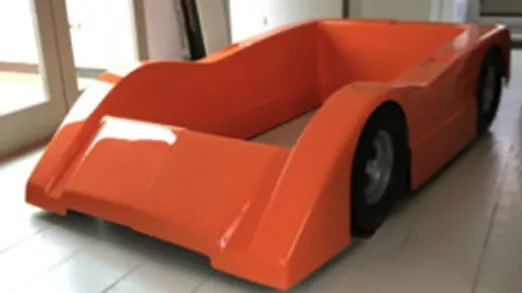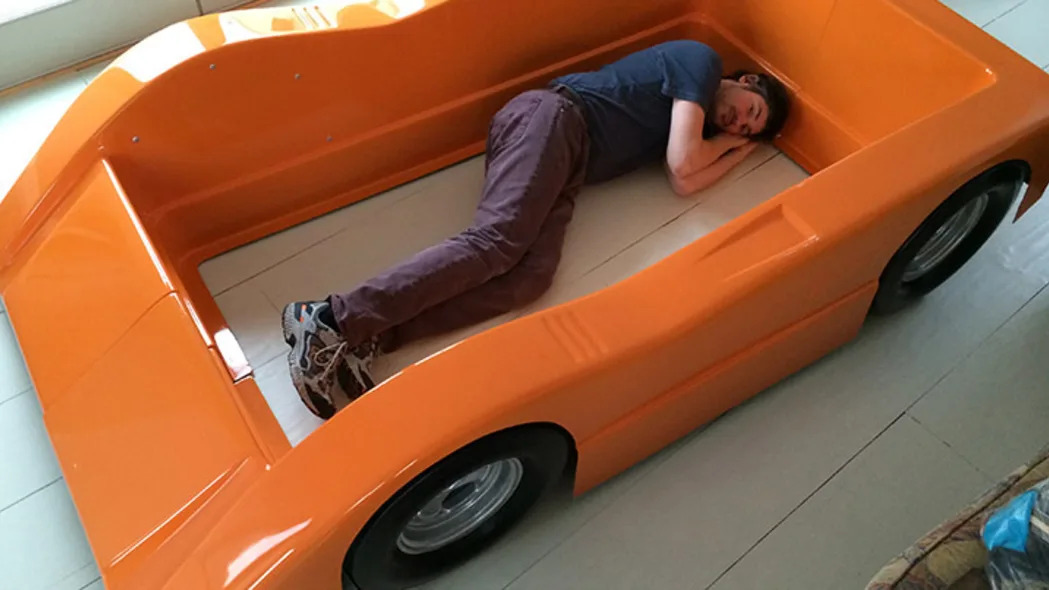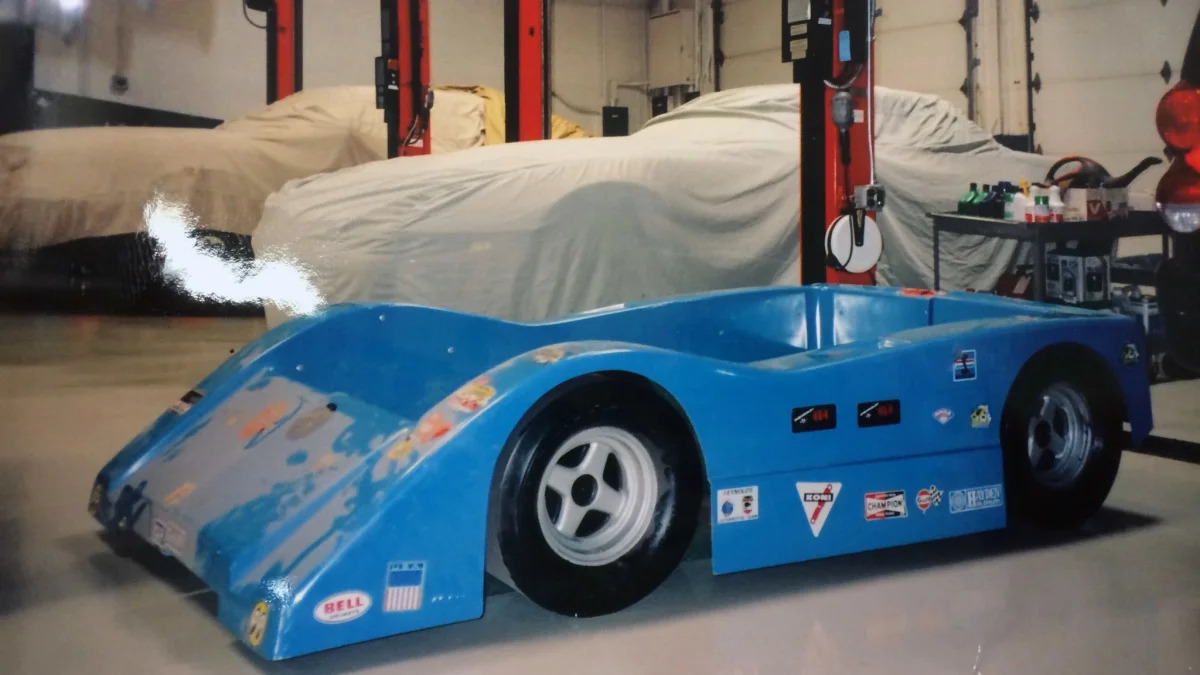It must have been quite a spectacle to watch as a full-size vehicle trailer pulled up in front of the Schorrs' suburban house and delivered a garish French Racing Blue sports car. But it might not have been all that odd.
"My world was the car world, and my dad was the car guy," Stuart Schorr, now Jaguar Land Rover communications chief, recalls of his youth. His father Marty was the editor in chief of high performance car magazines during the muscle-car era of the '60s and '70s. "I was the only kid who had a Plymouth Superbird parked in the driveway, who got driven to school in a hot-rodded Corvette."
Yet this vehicle was extraordinary, even by Schorr standards. Made of thick fiberglass, with four-spoke mags and racing slicks, it looked like a McLaren M6 Can-Am racer – wide, voluptuous, and impossibly low. But in place of niceties like the front intake, cockpit, and engine, it had a broad cutout the size and shape of a coffin. Also, it unbolted in the middle lengthwise. Workers hauled it into the house, one piece at a time, through the window, and bolted it together in Stuart's bedroom, finishing with a full-size twin mattress.
"When Stuart came home from school, he found the McLaren bed in his room," Marty Schorr says. "I'm pretty sure he slept in that bed until he went away to college." (This may have been the most unusually effective form of teen birth control. "No female ever saw that bed," Stuart confesses.)
One of the great mysteries of the bed was its provenance. "If you looked under the plastic tires, it had these stickers that said B.F. Meyers & Company." This was the imprint of Bruce Meyers, creator of the Meyers Manx: the flippant fiberglass wonder that ushered in – and was then summarily ushered out of – the Volkswagen dune buggy conversion market.


Did Bruce Meyers build a kids' bed? And, if so, why?
Bruce Meyers grew up near the Pacific Ocean in Southern California, surfing and diving illegally off the piers. "That's the kind of life I led as a boy," he says during an extensive interview. "It was one with a lot of intolerance for rules."
A thorough iconoclast, he attended art school. He spent time sailing. He lived on a coral atoll in the South Seas and ran a pearl trading post. And then he returned to Southern California and worked in a shipyard. "Boat building at that time was moving over from wooden to fiberglass construction. I did all the tooling," Meyers says, "so I became very proficient in the area of fiberglass production."
This confluence of skills led directly to Meyers' most iconic product, the Manx: the world's first lightweight fiberglass bodied dune buggy. The Manx perfectly captured the liberated, unorthodox tendencies of the time. "The dune buggy had a sense of freedom about it," Meyers says. "It thumbed its nose at the world."
But the era's anti-authoritarian spirit was also Meyers' undoing. "The world grabbed it and ran with it, and copied it. Which just ruined me." Meyers built only about 7,000 of his kits in total, but estimates that over 250,000 cheap rip-offs of his original design exist worldwide. With a factory, and employees and overhead to sustain, Meyers turned back to the literal drawing board. "When I lost to the copiers, I got very clever, and I popped up with other ideas to try and keep my company alive."
He built a fiberglass hot tub, but it didn't gain traction, an outcome Meyers blames on his ignorance of marketing. "The smartest thing I could have done was go and get Hugh Hefner and decorate it with naked girls. But I wasn't that smart." He created a vacuum-formed fiberglass bed-liner for pickup trucks, an idea that also flopped. And then he happened on a fresh concept. No doubt inspired by the widespread use of fiberglass in modern interior decor, Meyers decided to try making furniture. "I did another thing called the Night Racer," he says, "a little bed that looks like a McLaren racecar."
When asked the origin story on this outlier item, Meyers said that, "It just popped up as an idea. I sold some of them for a while – I doubt that we made over one or two hundred – but it didn't save the company. None of this stuff was strong enough to replace the Manx, the dune buggy," he says. "So we finally closed the doors, and there was an auction. And I went away, pissed."

Though often imitated, the Night Racer endures
The Night Racer fell victim to cheap imitators as well. While Marty Schorr remembers paying upwards of $500 for his automotive-grade Meyers original back in the early 1970s, other manufacturers began copying the design just a few years later, producing thin-shelled knock-offs that retailed at stores like Macy's for less than $200. These cheaper car beds even appeared in the consumer goods section of the 1976 New York Auto Show, using the Night Racer moniker. Similar beds are still available under the same name, today.
Still, the Schorrs managed to coax a decent amount of, ahem, mileage out of the bed. Marty featured a "test drive" of the Night Racer in one of his magazines, CARS, in 1972. Stuart remembers playing on it throughout his childhood. "I had a helmet, so we'd sit in the bed with a steering wheel and the helmet and play racecar – me and my sister, me and my friends." The bed even offered a sense of security. "From a physical standpoint, you felt really protected inside. There were high walls all around," Stuart says. "Though, I do remember after watching The Wizard of Oz thinking that the witch was going to ride her bicycle right up the foot of the bed. It had that nice low front end."
Eventually, he outgrew Night Racer, but he kept it in storage. And when he had a child of his own, he decided the bed should be hers. Worried that French Blue was not ideal for a young girl, the family decided to have the bed repainted in proper McLaren orange. "I tried to contact people at McLaren, McLaren's widow, no one would give me the paint code," Marty Schorr says. "Finally, I went to Oskar Kovaleski, who ran the Polish racing team for McLaren back in the 60s and 70s and said I needed the code that they painted their cars back then. He says, 'well if you promise not to tell anybody, it's a Chevrolet pickup truck color."
The bed was professionally stripped and dipped at the Saleen factory – alongside where the famed S7 supercar was being built – and sent back. With slightly more shame and self-awareness than her father, Stuart's daughter enjoyed the bed until she reached adolescence, at which point it was again put in storage.
With no more kids, grandkids a long way off, and storage at a premium, Stuart is hoping to find the right person to assume responsibility for the bed. "Someone who is a collector of things in one of these worlds – automotive, or Bruce Meyers, or Can Am. Someone who has the same passion for cars that my dad did." His dream? "To have some other kid grow up with the ultimate car guy bed from their ultimate car guy or car gal parents." We hope this bed-based dream comes true. And that whoever acquires it sends a video of its delivery.
Related Video:
"My world was the car world, and my dad was the car guy," Stuart Schorr, now Jaguar Land Rover communications chief, recalls of his youth. His father Marty was the editor in chief of high performance car magazines during the muscle-car era of the '60s and '70s. "I was the only kid who had a Plymouth Superbird parked in the driveway, who got driven to school in a hot-rodded Corvette."
Yet this vehicle was extraordinary, even by Schorr standards. Made of thick fiberglass, with four-spoke mags and racing slicks, it looked like a McLaren M6 Can-Am racer – wide, voluptuous, and impossibly low. But in place of niceties like the front intake, cockpit, and engine, it had a broad cutout the size and shape of a coffin. Also, it unbolted in the middle lengthwise. Workers hauled it into the house, one piece at a time, through the window, and bolted it together in Stuart's bedroom, finishing with a full-size twin mattress.
"When Stuart came home from school, he found the McLaren bed in his room," Marty Schorr says. "I'm pretty sure he slept in that bed until he went away to college." (This may have been the most unusually effective form of teen birth control. "No female ever saw that bed," Stuart confesses.)
One of the great mysteries of the bed was its provenance. "If you looked under the plastic tires, it had these stickers that said B.F. Meyers & Company." This was the imprint of Bruce Meyers, creator of the Meyers Manx: the flippant fiberglass wonder that ushered in – and was then summarily ushered out of – the Volkswagen dune buggy conversion market.


Did Bruce Meyers build a kids' bed? And, if so, why?
Bruce Meyers grew up near the Pacific Ocean in Southern California, surfing and diving illegally off the piers. "That's the kind of life I led as a boy," he says during an extensive interview. "It was one with a lot of intolerance for rules."
A thorough iconoclast, he attended art school. He spent time sailing. He lived on a coral atoll in the South Seas and ran a pearl trading post. And then he returned to Southern California and worked in a shipyard. "Boat building at that time was moving over from wooden to fiberglass construction. I did all the tooling," Meyers says, "so I became very proficient in the area of fiberglass production."
This confluence of skills led directly to Meyers' most iconic product, the Manx: the world's first lightweight fiberglass bodied dune buggy. The Manx perfectly captured the liberated, unorthodox tendencies of the time. "The dune buggy had a sense of freedom about it," Meyers says. "It thumbed its nose at the world."
But the era's anti-authoritarian spirit was also Meyers' undoing. "The world grabbed it and ran with it, and copied it. Which just ruined me." Meyers built only about 7,000 of his kits in total, but estimates that over 250,000 cheap rip-offs of his original design exist worldwide. With a factory, and employees and overhead to sustain, Meyers turned back to the literal drawing board. "When I lost to the copiers, I got very clever, and I popped up with other ideas to try and keep my company alive."
He built a fiberglass hot tub, but it didn't gain traction, an outcome Meyers blames on his ignorance of marketing. "The smartest thing I could have done was go and get Hugh Hefner and decorate it with naked girls. But I wasn't that smart." He created a vacuum-formed fiberglass bed-liner for pickup trucks, an idea that also flopped. And then he happened on a fresh concept. No doubt inspired by the widespread use of fiberglass in modern interior decor, Meyers decided to try making furniture. "I did another thing called the Night Racer," he says, "a little bed that looks like a McLaren racecar."
When asked the origin story on this outlier item, Meyers said that, "It just popped up as an idea. I sold some of them for a while – I doubt that we made over one or two hundred – but it didn't save the company. None of this stuff was strong enough to replace the Manx, the dune buggy," he says. "So we finally closed the doors, and there was an auction. And I went away, pissed."

Though often imitated, the Night Racer endures
The Night Racer fell victim to cheap imitators as well. While Marty Schorr remembers paying upwards of $500 for his automotive-grade Meyers original back in the early 1970s, other manufacturers began copying the design just a few years later, producing thin-shelled knock-offs that retailed at stores like Macy's for less than $200. These cheaper car beds even appeared in the consumer goods section of the 1976 New York Auto Show, using the Night Racer moniker. Similar beds are still available under the same name, today.
Still, the Schorrs managed to coax a decent amount of, ahem, mileage out of the bed. Marty featured a "test drive" of the Night Racer in one of his magazines, CARS, in 1972. Stuart remembers playing on it throughout his childhood. "I had a helmet, so we'd sit in the bed with a steering wheel and the helmet and play racecar – me and my sister, me and my friends." The bed even offered a sense of security. "From a physical standpoint, you felt really protected inside. There were high walls all around," Stuart says. "Though, I do remember after watching The Wizard of Oz thinking that the witch was going to ride her bicycle right up the foot of the bed. It had that nice low front end."
Eventually, he outgrew Night Racer, but he kept it in storage. And when he had a child of his own, he decided the bed should be hers. Worried that French Blue was not ideal for a young girl, the family decided to have the bed repainted in proper McLaren orange. "I tried to contact people at McLaren, McLaren's widow, no one would give me the paint code," Marty Schorr says. "Finally, I went to Oskar Kovaleski, who ran the Polish racing team for McLaren back in the 60s and 70s and said I needed the code that they painted their cars back then. He says, 'well if you promise not to tell anybody, it's a Chevrolet pickup truck color."
The bed was professionally stripped and dipped at the Saleen factory – alongside where the famed S7 supercar was being built – and sent back. With slightly more shame and self-awareness than her father, Stuart's daughter enjoyed the bed until she reached adolescence, at which point it was again put in storage.
With no more kids, grandkids a long way off, and storage at a premium, Stuart is hoping to find the right person to assume responsibility for the bed. "Someone who is a collector of things in one of these worlds – automotive, or Bruce Meyers, or Can Am. Someone who has the same passion for cars that my dad did." His dream? "To have some other kid grow up with the ultimate car guy bed from their ultimate car guy or car gal parents." We hope this bed-based dream comes true. And that whoever acquires it sends a video of its delivery.
Related Video:










Sign in to post
Please sign in to leave a comment.
Continue